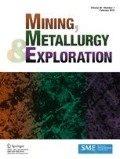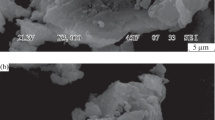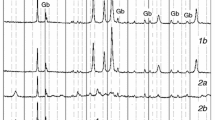Abstract
The oxidative degradation kinetics of chalcopyrite have been studied by thermogravimetric analysis (TGA). The obtained data are necessary for the kinetic description of the flash fusion process, which can contribute to the optimization of the smelting process in copper extractive metallurgy. Activation energy (Ea) evolutions of the involved processes have been determined by several isoconversional methods; in this sense, the chalcopyrite oxidation processes could be adequately described, among studied models (E1641–16, Ozawa–Flynn–Wall, Kissinger–Akahira–Sunose and Friedman), by the Kissinger–Akahira–Sunose kinetic model. Using this method, Ea and A values are found to be very dependent on the conversion. Under lower conversion levels, higher Ea and A values have been calculated with respect to that found for medium and higher conversion levels.













Similar content being viewed by others
References
Schlesinger ME, King MJ, Sole KC, Davenport WG (2011) Extractive metallurgy of copper. Elsevier, Amsterdam. https://doi.org/10.1016/C2010-0-64841-3
Feng Q, Wen S, Bai X, Chang W, Cui C, Zhao W (2019) Surface modification of smithsonite with ammonia to enhance the formation of sulfidization products and its response to flotation. Min Eng. https://doi.org/10.1016/j.mineng.2019.03.021
Zhao W, Liu D, Feng Q, Wen S, Chang W (2019) DFT insights into the electronic properties and adsorption mechanism of HS− on smithsonite (1 0 1) surface. Min Eng. https://doi.org/10.1016/j.mineng.2019.105846
Huang Z, Cheng C, Liu Z, Zeng H, Feng B, Zhong H, Fu W (2019) Utilization of a new gemini surfactant as the collector for the reverse froth flotation of phosphate ore in sustainable production of phosphate fertilizer. J Clean Prod. https://doi.org/10.1016/j.jclepro.2019.02.251
Huang Z, Cheng C, Liu Z, Feng B, Hu Y, Luo W, Fu W (2019) Highly efficient potassium fertilizer production by using a gemini surfactant. Green Chem. https://doi.org/10.1039/C8GC03487G
Huang Z, Cheng C, Liu Z, Luo W, Zhong H, He G, Fu W (2019) Gemini surfactant: a novel flotation collector for harvesting of microalgae by froth flotation. Bioresour Technol. https://doi.org/10.1016/j.biortech.2018.12.106
Yazawa A, Kameda A (1953) Copper smelting. I. Partial liquidus diagram for FeSFeO-SiO2 system. Tech. Rep. Tohoku Univ 16:40–58
Sharma RC, Chang YA (1980) A thermodynamic analysis of the copper sulfur system. Metall Transac. https://doi.org/10.1007/BF02670137
Dunn JG, Ginting A, O’Connor BH (1997) Quantitative determination of phases presents in oxidised chalcocite. J Therm Anal. https://doi.org/10.1007/bf01979548
Pérez-Fontes SE, Pérez-Tello M, Prieto-López LO, Brown F, Castillón-Barraza F (2007) Thermoanalytical study on the oxidation of sulfide minerals at high temperatures. J Min Metall Explor. https://doi.org/10.1007/bf03403377
Parra R, Parada R, Rodríguez M (2003) New approach for the optimization of copper concentrates flash combustion by the control of blends. Invited Lecture. Yazawa International Symposium on Metallurgical and Materials Processing: Principles and Technologies, TMS Annual Meeting and Exhibition, San Diego, 2–6 March
Araya RMP (2015) Combustión de concentrados de cobre en hornos de fusión flash. Ph D. Thesis, Universidad de Oviedo, Spain
Kim YH, Themelis NJ (1986) Effect of phase transformation and particle fragmentation on the flash reaction of complex metal sulfides. In: Gaskell DR, Hager JP, Hoffmann JE (eds) The reinhardt schuhmann international symposium on innovative technology and reactor design in extraction metallurgy. ASM International, Novelty, OH, pp 349–369
Jorgensen FRA, Koh PTL (2001) Combustion in flash smelting furnaces. JOM. https://doi.org/10.1007/s11837-001-0201-x
Parra Sánchez VR (2015) Estudio experimental y modelación matemática de la fragmentación de partículas sulfurosas de concentrado de cobre en un reactor de flujo laminar. Ph D Thesis. Universidad de Sonora, Mexico
ASTM Test Method E-1641. 1994. Standard test method for decomposition kinetics by thermogravimetry. ASTM Book of Standards 14.02. American Society for Testing and Materials, West Conshohocken, PA, pp 1042–1046
Ozawa T (1965) A new method of analyzing thermogravimetric data. Bull Chem Soc Jpn. https://doi.org/10.1246/bcsj.38.1881
Flynn JH, Wall LA (1966) A quick, direct method for the determination of activation energy from thermogravimetric data. J Polym Sci B Polym Phys. https://doi.org/10.1002/pol.1966.110040504
Kissinger HE (1956) Variation of peak temperature with heating rate in differential thermal analysis. J Res Natl Bur Stand. https://doi.org/10.6028/jres.057.026
Akahira T, Sunose T (1971) Method of determining activation deterioration constant of electrical insulating materials. Res Rep Chiba Inst Technol 16:22–31
Friedman HL (1960) Thermal degradation of plastics. I. the kinetics of polymer chain degradation. J Polym Sci A. https://doi.org/10.1002/pol.1960.1204514511
Živković ZD, Mitevska N, Savović V (1996) Kinetics and mechanism of the chalcopyrite-pyrite concentrate oxidation process. Thermochim Acta. https://doi.org/10.1016/0040-6031(96)02883-3
Piñeyro R, Pérez M, Parra R (2012) Estudio termoanalítico de la oxidación de partículas de concentrado de cobre. XXI Congreso Internacional Metalurgia Extractiva México, 16–18 May, 1:192–205
Dunn JG (1997) The oxidation of sulphide minerals. Thermochim Acta. https://doi.org/10.1016/s0040-6031(96)03132-2
Sonobe T, Worasuwannarak N (2008) Kinetic analyses of biomass pyrolysis using the distributed activation energy model. Fuel. https://doi.org/10.1016/j.fuel.2007.05.004
Brown ME (1998) Handbook of thermal analysis and calorimetry: principles and practice. Elsevier, Amsterdam
Acknowledgements
This study received financial support from Research and Transfer Policy Strategy of the University of Huelva (Call for Industrial Doctorate grants at the University of Huelva) and from the Atlantic Copper company.
Author information
Authors and Affiliations
Corresponding author
Ethics declarations
Conflicts of Interest
The authors declare that they have no conflict of interest.
Additional information
Publisher’s Note
Springer Nature remains neutral with regard to jurisdictional claims in published maps and institutional affiliations.
Rights and permissions
About this article
Cite this article
Vázquez, M., Moreno-Ventas, I., Raposo, I. et al. Kinetic Evolution of Chalcopyrite Thermal Degradation under Oxidative Environment. Mining, Metallurgy & Exploration 37, 923–932 (2020). https://doi.org/10.1007/s42461-020-00204-x
Received:
Accepted:
Published:
Issue Date:
DOI: https://doi.org/10.1007/s42461-020-00204-x




